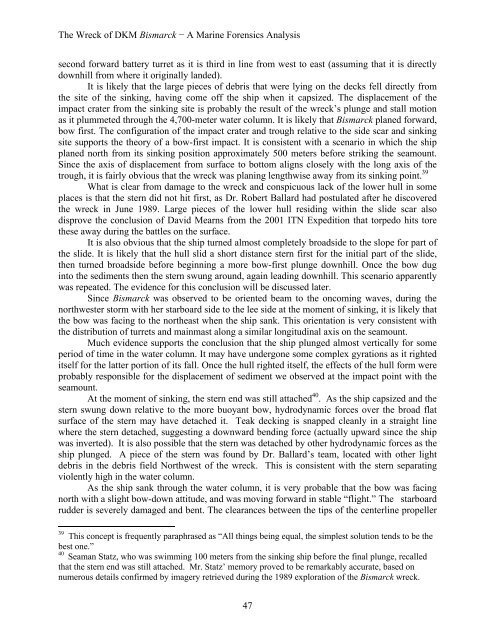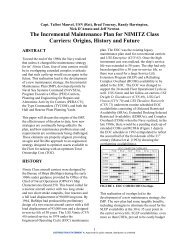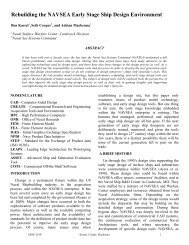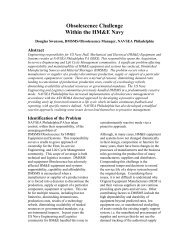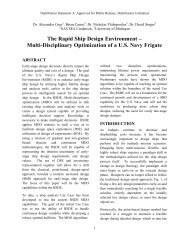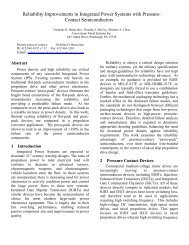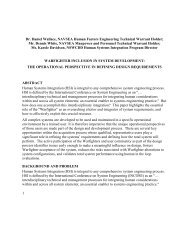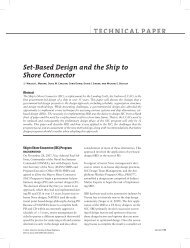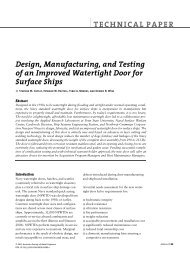The Wreck of DKM Bismarck − A Marine Forensics Analysis 1 The ...
The Wreck of DKM Bismarck − A Marine Forensics Analysis 1 The ...
The Wreck of DKM Bismarck − A Marine Forensics Analysis 1 The ...
You also want an ePaper? Increase the reach of your titles
YUMPU automatically turns print PDFs into web optimized ePapers that Google loves.
<strong>The</strong> <strong>Wreck</strong> <strong>of</strong> <strong>DKM</strong> <strong>Bismarck</strong> <strong>−</strong> A <strong>Marine</strong> <strong>Forensics</strong> <strong>Analysis</strong><br />
second forward battery turret as it is third in line from west to east (assuming that it is directly<br />
downhill from where it originally landed).<br />
It is likely that the large pieces <strong>of</strong> debris that were lying on the decks fell directly from<br />
the site <strong>of</strong> the sinking, having come <strong>of</strong>f the ship when it capsized. <strong>The</strong> displacement <strong>of</strong> the<br />
impact crater from the sinking site is probably the result <strong>of</strong> the wreck’s plunge and stall motion<br />
as it plummeted through the 4,700-meter water column. It is likely that <strong>Bismarck</strong> planed forward,<br />
bow first. <strong>The</strong> configuration <strong>of</strong> the impact crater and trough relative to the side scar and sinking<br />
site supports the theory <strong>of</strong> a bow-first impact. It is consistent with a scenario in which the ship<br />
planed north from its sinking position approximately 500 meters before striking the seamount.<br />
Since the axis <strong>of</strong> displacement from surface to bottom aligns closely with the long axis <strong>of</strong> the<br />
trough, it is fairly obvious that the wreck was planing lengthwise away from its sinking point. 39<br />
What is clear from damage to the wreck and conspicuous lack <strong>of</strong> the lower hull in some<br />
places is that the stern did not hit first, as Dr. Robert Ballard had postulated after he discovered<br />
the wreck in June 1989. Large pieces <strong>of</strong> the lower hull residing within the slide scar also<br />
disprove the conclusion <strong>of</strong> David Mearns from the 2001 ITN Expedition that torpedo hits tore<br />
these away during the battles on the surface.<br />
It is also obvious that the ship turned almost completely broadside to the slope for part <strong>of</strong><br />
the slide. It is likely that the hull slid a short distance stern first for the initial part <strong>of</strong> the slide,<br />
then turned broadside before beginning a more bow-first plunge downhill. Once the bow dug<br />
into the sediments then the stern swung around, again leading downhill. This scenario apparently<br />
was repeated. <strong>The</strong> evidence for this conclusion will be discussed later.<br />
Since <strong>Bismarck</strong> was observed to be oriented beam to the oncoming waves, during the<br />
northwester storm with her starboard side to the lee side at the moment <strong>of</strong> sinking, it is likely that<br />
the bow was facing to the northeast when the ship sank. This orientation is very consistent with<br />
the distribution <strong>of</strong> turrets and mainmast along a similar longitudinal axis on the seamount.<br />
Much evidence supports the conclusion that the ship plunged almost vertically for some<br />
period <strong>of</strong> time in the water column. It may have undergone some complex gyrations as it righted<br />
itself for the latter portion <strong>of</strong> its fall. Once the hull righted itself, the effects <strong>of</strong> the hull form were<br />
probably responsible for the displacement <strong>of</strong> sediment we observed at the impact point with the<br />
seamount.<br />
At the moment <strong>of</strong> sinking, the stern end was still attached 40 . As the ship capsized and the<br />
stern swung down relative to the more buoyant bow, hydrodynamic forces over the broad flat<br />
surface <strong>of</strong> the stern may have detached it. Teak decking is snapped cleanly in a straight line<br />
where the stern detached, suggesting a downward bending force (actually upward since the ship<br />
was inverted). It is also possible that the stern was detached by other hydrodynamic forces as the<br />
ship plunged. A piece <strong>of</strong> the stern was found by Dr. Ballard’s team, located with other light<br />
debris in the debris field Northwest <strong>of</strong> the wreck. This is consistent with the stern separating<br />
violently high in the water column.<br />
As the ship sank through the water column, it is very probable that the bow was facing<br />
north with a slight bow-down attitude, and was moving forward in stable “flight.” <strong>The</strong> starboard<br />
rudder is severely damaged and bent. <strong>The</strong> clearances between the tips <strong>of</strong> the centerline propeller<br />
39<br />
This concept is frequently paraphrased as “All things being equal, the simplest solution tends to be the<br />
best one.”<br />
40<br />
Seaman Statz, who was swimming 100 meters from the sinking ship before the final plunge, recalled<br />
that the stern end was still attached. Mr. Statz’ memory proved to be remarkably accurate, based on<br />
numerous details confirmed by imagery retrieved during the 1989 exploration <strong>of</strong> the <strong>Bismarck</strong> wreck.<br />
47


